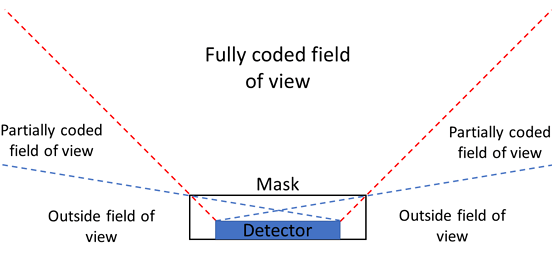Coded aperture imaging (CAI) works by casting the shadow of a mask from a source onto a detector. If the mask’s shadow fully covers the detector, the source is said to be in the fully coded field of view. If the shadow partially covers the detector, it’s in the partially coded field of view. A diagram of the different source placement locations is shown below.
“Ghosting” is a side effect of CAI when a source is in the partially coded field of view but creates the impression that there is a source in the field of view. H3D uses mask-antimask CAI to eliminate artifacts from sources outside the field of view of the mask, but ghosts can still occur in the partially coded field of view. This case study will show scenarios where ghosting can occur, and how to avoid this mistake during a measurement.
Trial 1: Source in fully coded field of view
This measurement was taken using one Co-57 source in the fully coded field of view (inside the red box). The radiation image accurately captures the location of the source.
Trial 2: Source in partially coded field of view
This measurement was taken with a single Co-57 source placed in the partially coded field of view. Since some of the radiation was able to be detected, a radiation image could still be created. However, the partial shadow caused by the source placement made the radiation image appear on the opposite side of the optical image.

Trial 3: Sources outside the partially coded field of view
This measurement was performed with the Co-57 source placed outside the partially coded field of view. Since no radiation from this source passed through the mask, not even a ghost radiation image could occur. And, of course, since the low-energy radiation could not be used by the H420’s Compton imaging technique, no radiation image was produced from this measurement.
In order for the source to be outside the partially coded field of view, the source placement looks like this:
Conclusions
It is very important to know when a source is inside the fully coded field of view (within the red box on image) or partially coded field of view (close to the edge of the red box but not inside). If you don’t ensure your low-energy source is in the fully coded field of view when using CAI techniques, you run the risk of false radiation images appearing in your measurement.



